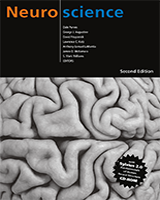By agreement with the publisher, this book is accessible by the search feature, but cannot be browsed.
NCBI Bookshelf. A service of the National Library of Medicine, National Institutes of Health.
Purves D, Augustine GJ, Fitzpatrick D, et al., editors. Neuroscience. 2nd edition. Sunderland (MA): Sinauer Associates; 2001.

Neuroscience. 2nd edition.
Show detailsThe cerebral ventricles are a series of interconnected, fluid-filled spaces that lie in the core of the forebrain and brainstem (Figure 1.17). The presence of ventricular spaces in the various subdivisions of the brain reflects the fact that the ventricles are the adult derivatives of the open space or lumen of the embryonic neural tube (see Chapter 22). Although they have no unique function, the ventricular spaces present in sections through the brain provide another useful guide to location. The largest of these spaces are the lateral ventricles (one within each of the cerebral hemispheres). These particular ventricles are best seen in frontal sections, where their ventral surface is usually defined by the basal ganglia, their dorsal surface by the corpus callosum, and their medial surface by the septum pellucidum, a membranous tissue sheet that forms part of the midline sagittal surface of the cerebral hemispheres. The third ventricle forms a narrow midline space between the right and left thalamus, and communicates with the lateral ventricles through a small opening at the anterior end of the third ventricle (called the interventricular foramen). The third ventricle is continuous caudally with the cerebral aqueduct, which runs though the midbrain. At its caudal end, the aqueduct opens into the fourth ventricle, a larger space in the dorsal pons and medulla. The fourth ventricle narrows caudally to form the central canal of the spinal cord. The ventricles are filled with cerebrospinal fluid, and the lateral, third, and fourth ventricles are the site of the choroid plexus, which produces this fluid. The cerebrospinal fluid percolates through the ventricular system and flows into the subarachnoid space through perforations in the thin covering of the fourth ventricle; it is eventually absorbed by specialized structures called arachnoid villi or granulations (see Figure 1.18), and returned to the venous circulation.

Figure 1.17
The ventricular system of the human brain. (A) Location of the ventricles as seen in a transparent left lateral view. (B) Table showing the ventricular spaces associated with each of the major subdivisions of the brain. (See Chapter 22 for an account (more...)

Figure 1.18
The meninges. Upper left panel is a midsagittal view showing the three layers of the meninges in relation to the skull and brain. Right panels are blowups to show detail.
- The Ventricular System - NeuroscienceThe Ventricular System - Neuroscience
Your browsing activity is empty.
Activity recording is turned off.
See more...